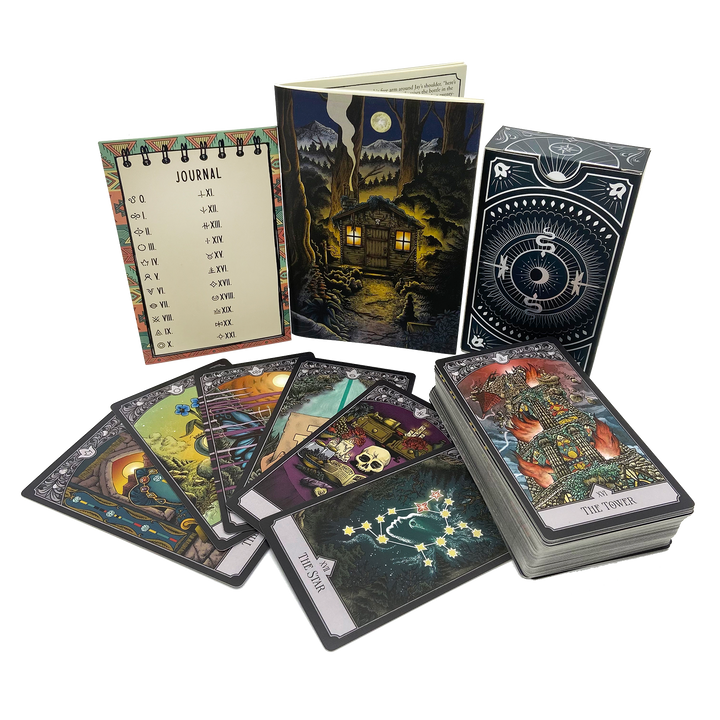
The Light in the Mist
Review
Game Description
“When your friend’s mysterious disappearance results in the discovery of an unusual item, you suddenly find yourself embarking on a journey through time and memory. Experience The Light in the Mist’s unique choose-your-own-path style gameplay as you solve a variety of challenges and lose yourself in a character-driven narrative told through an object that serves as a tarot deck, a puzzle game, and a work of art.”
Personal Experience
Coming off the high of playing The Emerald Flame, I was stoked to have another PostCurious puzzle narrative waiting for me to play through. My expectations were sky-high, so imagine my surprise when they were exceeded! I assumed The Light in the Mist would be good, but what I didn’t guess is just how good it would be. It’s staggeringly good. It’s my new favorite puzzle game experience.
In what I’d call the second–most novel medium for a puzzle game I’ve seen, The Light in the Mist is played across the entirety of a custom-designed tarot deck. The cards are accompanied by a small booklet that contains the prompts and potential solutions for each of the puzzles. Unless you need a hint, the game can be played completely offline.
I played the game over the course of several weeks in December, taking my time and not rushing through the experience. The game is broken up into distinct, non-linear puzzles, making it very easy to play in small bursts; I could pick it up and solve a single puzzle, without having to commit an entire evening to it. The ‘pick up/put down’ nature of my experience makes it hard to estimate the exact time I spent with the game, but I’d say it ended somewhere around 12-15 hours. I had a fantastic time throughout, with an ending that felt like it had arrived at exactly right time.
Narrative
Narratively the game was quite emotional. You’re using the tarot deck of a missing friend, Sam, to navigate a surreal, almost dream-like landscape to try and track her down. You’ll deal with your own inner-demons while you learn more about hers. Each puzzle solved provides a glimpse into the life of Sam. Some puzzles have multiple solutions, which often lead to re-contextualizing a scene you have just read with new information from a different point in time. The non-linear nature of the experience only enhances the dream-like nature of the experience. Put all together, this does a great job of making Sam a three-dimensional character, someone who has a rich and complex inner-life, and completely avoiding the missing woman trope often present in puzzle mystery games.
The game does tackle some sensitive topics and—by and large—does so with grace and sensitivity. Navigating life as a teenager is hard, especially when things at home aren’t as stable as you’d like them to be; I really empathized with Sam as I learned more about her particular story. There was one particular storyline involving Sam’s father that I felt read a little less nuanced and a little more caricatured, but it’s a very minor quibble in an otherwise very excellent narrative and your mileage may vary on that particular point. Content warnings are available in the front of the book, which is a thoughtful touch that I appreciated.
Illustrated by Jack Fallows, the artwork on the cards creates an ambiance that synthesizes the narrative environment with subtle inspiration from the classic Smith-Waite deck. Above everything else, it feels like an atmospheric, moody tarot deck, one that you wouldn’t blink twice at receiving a reading from.
Puzzle Play
The puzzle play in the game is uniformly excellent, with puzzles ranging from fairly easily to devilishly clever. (In fact, The Devil (XV) was the hardest puzzle in the game for me!) Aside from a fixed starting and end puzzle, the game can be played through in any order desired. This is narratively thematic and adds a lot to the vibe of the overall experience. The only (minor) downside is that the difficulty and time per puzzle is scattershot, instead of ramping up smoothly. To help with this issue, the game highlights a few optimal starting puzzles for people who are newer to the hobby. I chose to let the cards guide me, as the game recommends, and drew randomly each time I was ready for a new puzzle, guaranteeing that I would experience the game differently than anyone else who has played the game.
There are 22 puzzles in the standard edition, one for each of the Major Arcana in the deck. Most puzzles pull in additional cards from the Minor Arcana to complete them—sometimes one or two, sometimes an entire suit. Impressively, despite most of the Minor Arcana being reused for multiple puzzles, each puzzle feels both unique and thematically appropriate for the Major Arcana. It’s very thoughtful design work.
Most of the puzzles were pretty smooth solves. Though there were two or three that relied on being able to distinguish colors to get by, requiring me to seek outside help to get past them. In an experience with so many puzzles it was a little less disheartening than other color-centric puzzle experiences.
The hint system is the same as The Emerald Flame, offering progressive hints and a spoiler-free method of checking your answers.
Recommendation
The Light in the Mist is a phenomenal game and melds medium, narrative, and puzzle play into an experience that is greater than the sum of its parts. I whole-heartedly recommend it to anyone who is looking for something thoughtful and memorable and wants to experience the best of what the puzzle game industry has to offer.

Details
Type of Game: At Home Puzzle Game
Date Played: December 2022
Price: $32 (Standard) $95 (Deluxe)
Company: PostCurious
Website: https://getpostcurious.com
Team Size: 1
Colorblind-friendly: Mostly
Outcome: Win



